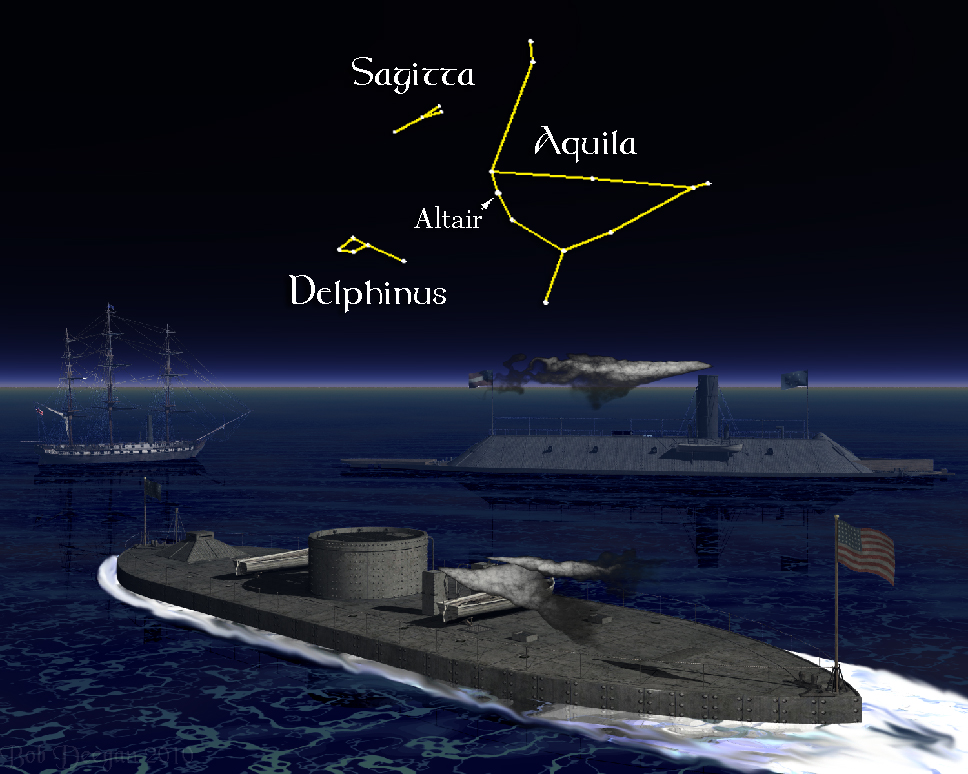
For the week including March 12, 2010

DAWN OF THE IRONCLADS
Most of the requests I get from readers come in the form of questions about constellations or planets, but recently someone wrote and asked what stars were rising before dawn on the morning that the Ironclads fought in Virginia.
Well, John, the answer is shown in our illustration. The constellations of Sagitta, the Arrow, Delphinus, the Dolphin, and Aquila, the Eagle, with its bright star Altair were just above the eastern horizon on that day. If you venture out before sunrise you will see these same stars through all of March.
For those who might be curious, this week marks the 148th anniversary of one of the most important battles of the Civil War and the end of the era of wooden warships.
The Confederacy, seeking to break a Union blockade of Hampton Roads, had seized on the idea of armor plating a warship to make it invulnerable to cannon fire. They grafted two-inch thick iron plates onto the hull of a captured Union steam frigate and renamed it the C.S.S. Virginia. (But the maritime tradition that a ship always bears the name of its hull held strong and the Virginia was more popularly known as the Merrimack. (Not to be confused with the Merrimac, the name of another Union vessel.) On March 8th, 1862, weighed down by its armor, the Virginia slowly lumbered out to meet the Union blockading ships Cumberland and Congress. (A third ship, the Minnesota, had run aground and could only watch.) The Virginia steamed right through cannon fire from both opponents and sank the Cumberland using an iron ram welded to its bow, but the ram broke off in the sinking Cumberland and almost doomed both ships. The Virginia made short work of the Congress, but withdrew for the night to make repairs. The stranded Minnesota could wait until dawn.
At sunrise, Virginia sailors reported sighting an odd “cheesebox on a shingle” floating near the Minnesota. The commander of the Virginia thought that the Union captain had moved the ship’s boiler to a raft and was making repairs. To the commander's surprise, he was facing the Monitor instead.
The Union had gotten word of the Virginia’s construction and had prepared an answer. Three ship designs were put forward and two were very much like Confederate efforts. But Abraham Lincoln favored the revolutionary work of John Ericsson whose blueprint for a River Monitor was so extraordinary that many naval engineers doubted the ship could even float. The Monitor went from the drawing board to its arrival in Hampton Roads in just a few months. Less than half the size of the Virginia and outgunned ten cannons to two, the Monitor had greater speed and maneuverability. Its unique swiveling turret allowed it to fire from any angle and its two cannons were monsters that would have sunk the Virginia in minutes had the Confederates mounted one-inch thick armor as originally planned. But the inches they had were enough. The ships bounced cannonballs off each other and even collided a few times, but neither could vanquish the other.After four and a half hours of battle the Virginia withdrew up the James River. It would never have another victory and was burned two months later when the Confederates abandoned Norfolk. The Monitor would sink in a gale off North Carolina -- its swiveling turret design is still found on today’s battleships.
Unless otherwise indicated, all content of this web site is the copyright of Robert Deegan and all rights are reserved.
For more information, or to comment, please contact: Bob@NightSkies.org